Taxonomy, Evolutionary and Dispersal Events of Pig-Tailed Macaque, Macaca nemestrina (Linnaeus, 1766) in Southeast Asia with Description of a New Subspecies, Macaca nemestrina perakensis in Malaysia
- PMID: 35003344
- PMCID: PMC8685347
- DOI: 10.6620/ZS.2021.60-50
Taxonomy, Evolutionary and Dispersal Events of Pig-Tailed Macaque, Macaca nemestrina (Linnaeus, 1766) in Southeast Asia with Description of a New Subspecies, Macaca nemestrina perakensis in Malaysia
Abstract
The pig-tailed macaque, Macaca nemestrina, which is distributed in Peninsular Malaysia, Thailand, Borneo, and Sumatra, has been the subject of unstable and changing taxonomic entity in the M. nemestrina group. This species is involved with a human-macaque conflict in Malaysia and at the same time played an important role in the ethnozoological culture of Malaysian. Even so, comprehensive phylogenetic, population genetics and biogeographical analysis of M. nemestrina in Malaysia are non-existent after decades of intensive research on the genus itself. Thus, we conducted the first comprehensive genetic study of M. nemestrina in Malaysia, based on three mitochondrial loci-Cytochrome b (567 bp), D-loop (398 bp), and COI (577 bp)-from 27 individuals representing Malaysia, plus an additional 26 sequences of Southeast Asian macaques from Genbank. Comparative biogeographical analysis in this study supports the positions of M. nemestrina in M. nemestrina groups as opposed to the silenus or Sulawesi groups. Results from this study also indicate that Bornean populations are the first extant lineages to separate from the other examined lineages of M. nemestrina, M. leonina, M. pagensis, and M. siberu in Southeast Asia. Molecular clock analysis suggested that M. nemestrina arrived in the Malay Peninsula about 0.32 million years ago (MYA). Our results indicate that the population of pig-tailed macaque from Perak (west Peninsular Malaysia) differs genetically based on all phylogenetic and population genetic analyses. Morphologically, Perak's pig-tailed macaque shows brighter coloration than M. n. nemestrina. Thus, we proposed a new subspecies for Perak's pig-tailed macaque as Macaca nemestrina perakensis distributed in the state of Perak, Peninsular Malaysia. This research helps resolve the taxonomic position and population genetics of pig-tailed macaque in Malaysia, which contribute directly to conservation and management of the species in Malaysia.
Keywords: Cercopithecinae; Macaca nemestrina; Phylogeography; Pig-tailed macaque; Taxonomy.
Figures
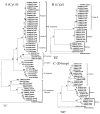
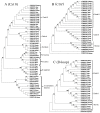
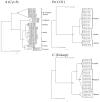
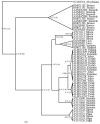
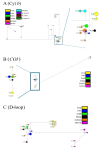



Similar articles
-
Macaca fascicularis and Macaca nemestrina infected with zoonotic malaria parasites are widely distributed in Sarawak, Malaysian Borneo.Sci Rep. 2022 Jun 21;12(1):10476. doi: 10.1038/s41598-022-14560-9. Sci Rep. 2022. PMID: 35729212 Free PMC article.
-
Unveiling the Gut Microbiota of Pig-Tailed Macaque (Macaca nemestrina) in Selected Habitats in Malaysia.J Med Primatol. 2024 Oct;53(5):e12737. doi: 10.1111/jmp.12737. J Med Primatol. 2024. PMID: 39323065
-
[Measurement and analysis of hematology and blood chemistry parameters in northern pig-tailed macaques (Macaca leonina)].Dongwuxue Yanjiu. 2013 Apr;34(2):89-96. doi: 10.3724/SP.J.1141.2013.02089. Dongwuxue Yanjiu. 2013. PMID: 23572357 Review. Chinese.
-
Phylogenetic relationships of Malaysia's long-tailed macaques, Macaca fascicularis, based on cytochrome b sequences.Zookeys. 2014 May 8;(407):121-40. doi: 10.3897/zookeys.407.6982. eCollection 2014. Zookeys. 2014. PMID: 24899832 Free PMC article.
-
The Peopling and Migration History of the Natives in Peninsular Malaysia and Borneo: A Glimpse on the Studies Over the Past 100 years.Front Genet. 2022 Jan 27;13:767018. doi: 10.3389/fgene.2022.767018. eCollection 2022. Front Genet. 2022. PMID: 35154269 Free PMC article. Review.
Cited by
-
Molecular phylogeny confirms the subspecies delineation of the Malayan Siamang (Symphalangussyndactyluscontinentis) and the Sumatran Siamang (Symphalangussyndactylussyndactylus) based on the hypervariable region of mitochondrial DNA.Biodivers Data J. 2024 Apr 25;12:e120314. doi: 10.3897/BDJ.12.e120314. eCollection 2024. Biodivers Data J. 2024. PMID: 38707255 Free PMC article.
-
High-throughput DNA metabarcoding for determining the gut microbiome of captive critically endangered Malayan tiger (Pantheratigrisjacksoni) during fasting.Biodivers Data J. 2023 Sep 5;11:e104757. doi: 10.3897/BDJ.11.e104757. eCollection 2023. Biodivers Data J. 2023. PMID: 37711366 Free PMC article.
-
Interspecific variation in the diet of Symphalangussyndactylus and Macacanemestrina at Genting Highlands, Pahang, Peninsular Malaysia.Biodivers Data J. 2024 May 22;12:e122453. doi: 10.3897/BDJ.12.e122453. eCollection 2024. Biodivers Data J. 2024. PMID: 38817270 Free PMC article.
-
Dietary Habits of Free-ranging Banded Langur (Presbytis femoralis) in a Secondary-human Modified Forest in Johor, Malaysia.Zool Stud. 2021 Nov 16;60:e67. doi: 10.6620/ZS.2021.60-67. eCollection 2021. Zool Stud. 2021. PMID: 35774255 Free PMC article.
-
Historical Demography and Species Distribution Models Shed Light on Speciation in Primates of Northeast India.Ecol Evol. 2025 Feb 25;15(2):e70968. doi: 10.1002/ece3.70968. eCollection 2025 Feb. Ecol Evol. 2025. PMID: 40008062 Free PMC article.
References
-
- Abdul-Latiff MAB, Ampeng A, Yaakop S, Md-Zain BM. 2014a. Phylogenetic relationships of Malaysia’s pig-tailed macaque Macaca nemestrina based on D-loop region sequences. AIP Conf Proc 1614:772–776. doi:10.1063/1.4895300.
-
- Abdul-Latiff MAB, Abdul-Patah P, Yaakop S, Md-Zain BM. 2017a. Aiding pest control management of long-tailed macaques (Macaca fascicularis fascicularis) in Malaysia by using molecular markers of mitochondrial DNA. AIP Conf Proc 1891(1):020003. doi:10.1063/1.5005336.
-
- Abdul-Latiff MAB, Aifat NR, Yaakop S, Md-Zain BM. 2017b. A noninvasive molecular approach: Exploiting species-locus-specific PCR primers in defeating numts and DNA cross-contamination of Cercopithecidae. J Anim Plant Sci 27:1015–1023.
-
- Abdul-Latiff MAB, Baharuddin H, Abdul-Patah P, Md-Zain BM. 2019. Is Malaysia’s banded langur, Presbytis femoralis femoralis, actually Presbytis neglectus neglectus? Taxonomic revision with new insights on the radiation history of the Presbytis species group in Southeast Asia. Primates 60:63–79. doi:10.1007/s10329-018-0699-y. - PubMed
LinkOut - more resources
Full Text Sources
